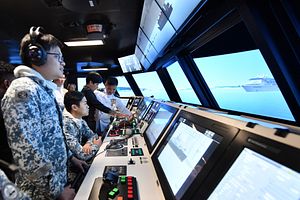Last week, Singapore held a commissioning ceremony for three of its locally built and designed warships. The ceremony represented yet another key step forward for a key line item within Singapore’s broader development of its naval capabilities.
As I have been noting in these pages, one of the many manifestations of the modernization of the Republic of Singapore Navy (RSN) has been the replacement of its existing fleet of Fearless-class patrol vessels, which have been in service for over two decades, with locally built and designed Littoral Mission Vessels (LMVs) that represent a marked improvement over their predecessor.
The progress on the LMV program has been continuing on over the past year or so, with the launching of the ships completed early last yet and some of them in fact being used in security engagements at home and abroad. And more steps were expected into 2020 as well, including finalizing commissioning of these vessels and their integration into Singapore’s wider capabilities in line with the country’s previous goal of having all eight of them fully operational by 2020.
Last week, Singapore’s LMV program was in the headlines again with another commissioning ceremony for three LMVs. A scheduled ceremony was held for the RSN’s three remaining LMVs at Tuas Naval Base.
According to Singapore’s defense ministry (MINDEF), the ceremony for the vessels – RSS Fortitude, RSS Dauntless and RSS Fearless – was officiated by Minister for Manpower and Second Minister for Home Affairs Josephine Teo and attended by others as well including Chief of Navy Rear-Admiral Lew Chuen Hong as well as senior officials from the Ministry of Defense and the Singapore Armed Forces.
The ceremony itself consisted of a routine series of interactions, including remarks by Teo. In her remarks, Teo congratulated the RSN and its partners for the completion and operationalization of all eight LMVs within a short span of just four and a half years since the launch of the first LMV and also noting the significance of the program, including its significant manpower savings. Teo labeled the LMVs “quintessentially Singaporean,” both in terms of it being built locally but also being testament to the country’s determination to defend itself despite constraints.
With the LMV program now complete in terms of commissioned vessels, the focus will shift to other indicators of progress, including how Singapore uses these ships and integrates it with its other capabilities. Thus far, per MINDEF, the LMVs have already participated in a series of operations, be it domestic security operations for the past U.S.-North Korea Singapore Summit or overseas exercises such as the inaugural ASEAN Multilateral Naval Exercise in Thailand in 2017.

































